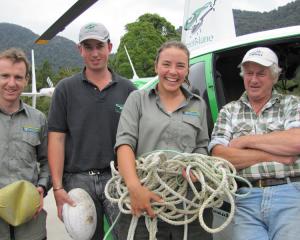The board organised a community clean-up day in 2009, during which 25 people filled three trailers with rubbish collected from the seaward side of the estuary.
In August last year, Mr Weatherall organised a group of probation workers to collect rubbish on the western side of the estuary.
Over one week, the 10 workers filled three skips with rubbish, including 35 car tyres, milk crates, large plastic bottles, wood and sporting equipment, leading him to wonder where the rubbish came from.
Mr Weatherall understood some may have been there for a long time, or discarded from passing cars, but rubbish continued to pile up in the waterway and he was organising another group of probation workers for another clean-up operation.
"The reality is that the wetland area up by the golf club is really cool.
It's awesome, but it's just littered with rubbish - boxes and wood and sizeable rubbish," he said.
Mr Weatherall had been in contact with the Dunedin City Council and Otago Regional Council, and while happy for the community board to lobby for its cleanliness, he believed the councils needed to talk to each other to solve the problem.
The public also needed to take responsibility for their rubbish, rather than carelessly discarding it.
"It's a fantastic nesting site for the pukeko.
There is that wildlife component there, as well as keeping the waterways clean."
Council solid waste manager Ian Featherston believed the council-owned Green Island landfill at the head of the estuary was not to blame.
"Our consent says we've got to keep our rubbish away from the estuary, so we try to keep our area clean as best we can," he said.
Litter screens were in place to catch wind-blown rubbish, and boundary audits were carried out regularly, although birds picking up rubbish and dropping it could account for some of the dumped items.
Transpacific Industries Group Ltd Fairfield Landfill manager Rangi Lord said wind fences were in place at the landfill and "litter pickers" collected rubbish weekly from the Fairfield side of the estuary.
However, he admitted "there is likely to be a little bit of litter that goes into the estuary proper".
No clean-ups of the wider estuary area had been carried out by landfill staff, but he was "happy to spend time with interested parties" to discuss the rubbish issue.
Otago Regional Council environmental services manager Martin King said the council's responsibility for the estuary ended at the high tide mark and it would only investigate if pollution became an issue.
Anyone caught dumping contaminants in waterways could face a fine of up to $600,000.
However, he believed most of the materials "derive from stormwater events" and, aside from the board, no-one, to his knowledge, had complained to the council about rubbish in the estuary.
The ORC did not usually carry out clean-ups, but did provide a skip for one of the board's endeavours, he said.
DCC roading maintenance engineer Peter Standring said the council had issues with people littering, and illegally dumping within road reserves.
People caught littering could be fined $100 under a council bylaw for dropping anything from an apple core to a drink can, while those dumping larger items could face a fine of $400 upwards under the Litter Act.
Advertisement





